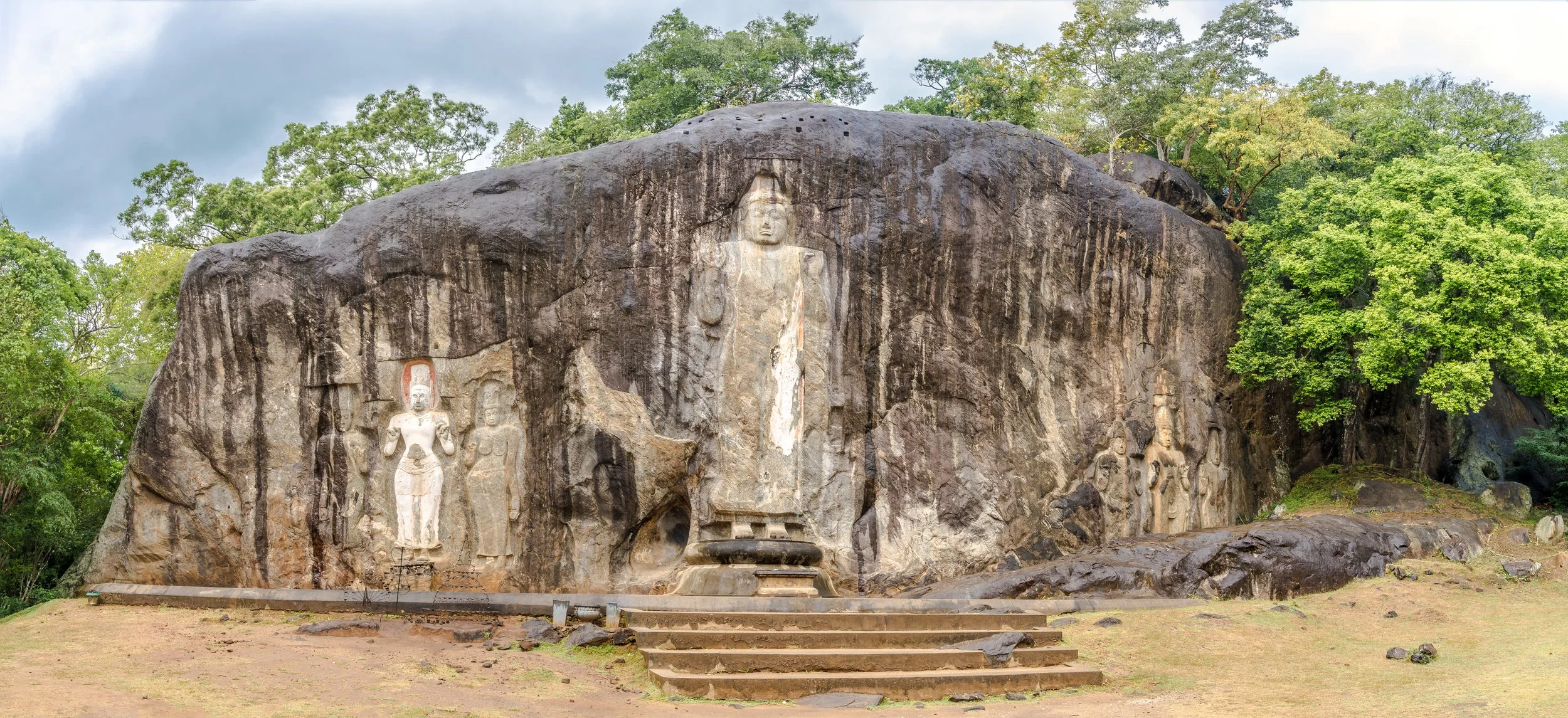Buduruwagala
At a Glance
Here, the pilgrim encounters remnants of the Mahayana in Sri Lanka, with seven massive statues carved into rock thought to depict Avalokiteshvara, Tara, Maitreya, Manjushri, and Vajrapani.
The Story
This southern rock-cut temple complex contains seven colossal statues and is believed to have belonged to a monastery following the Mahayana tradition. The statues date back to the 10th century CE. The rock statues of Buduruwagala were undoubtedly influenced by the southern Indian Pallava art, which peakedin the 7th and 8th century C.E. These sculptures have been dated back to the late Anuradhapura period, when the Mahayana school of Buddhism became prominent in Sri Lanka and tantric cults were influential for a brief period. Buduruwagala is the only ancient Buddhist monument of the Sinhalese civilization that contains distinct tantric representations. Traditionally, Mahayana Buddhism played a more important role in the works of art in the south of the island than in Anuradhapura, which was the focal point of the Theravada-domiated Sinhalese civilization. The southeastern part of the island was often not under control of the Anuradhapura kingdom and formed often a separate kingdom called Rohana in the Pali chronicles or Ruhunu in Sinhalese language.
Here the central Buddha statue stands 16 meters high, the biggest on the island. It still bears traces of the original stuccoed robe including an orange streak indicating that it was once brightly painted. The rock face above the Buddha's head has square holes indicating that the statue once was protected and adorned with a canopy or some sort of umbrella. This would have served dual purpose as a sign of respect and also a weather protection.
The Buduruwagala Buddha is in the Samabhanga posture, a straight and very erect posture. This Samabhanga posture was the common posture of almost all standing Buddhas sculpted during the Anuradhapura period. The Buddha is depicted in the Abhaya mudra with his right hand upwards and the palm forward. Abhaya mudra represents kindness, reassurance and freedom from fear. This is also the mudra used to depict the calming of the attacking elephant, one of the great deeds of the Buddha. The fingers of his left hand are bent slightly to hold the robe.
The Buddha statue is depicted in Abhaya Mudra gesture, lifting his right hand upwards with the palm forwards, to bless the arriving devotee. Abhaya is the posture of even-tempered kindness and reassurance and granting freedom from fear. With this gesture the Buddha was once capable to calm down an attacking elephant. The Buduruwagala Buddha has bent the fingers of his left hand to hold the robe.
The central of the three figures to the Buddha's right represents the bodhisattva Avalokiteshvara. The Avalokiteshvara sculpture still retains much of its white finish. Avalokiteshvara as well as several of the other figures hold up their right hands with two fingers bent down touching the palm. This beckoning gesture called Katakahasta, or Katakamudra invites devotees to come forward and worship in an atmosphere of peace.To the left of Avalokiteshvara is the unique example of a colossal female figure in Sri Lanka. This figure, holding a graceful curved hip posture, is thought to be his consort,the bodhisattva Tara. Tara holds up her right hand in the same mudra as Avalokitshvara. Her left hand hangs down holding a Purnakhumbha, the jar of plenty.
On the left side of the Buddha’s left-hand side, the richly crowned figure at the centre of the group is often proposed to represent the future Buddha, Maitreya. On his left stands Vajrapani, who is depicted holding a vajra. The next figure’s identification is unsure. Some speculate that it might be bodhisattva Manjushri, while others postulate that it may be either Vishnu or Brahma.
Beside the main image’s right foot statue is a large (3 ft by 4 ft ) receptacle hole, which is carved in the shape of the flame from an oil lamp. Locals assert that this hole remains always wet from a liquid that smells like mustard oil and that there is no explainable source or reason for this phenomenon. Traditionally, devotees anointed their foreheads with oil from this hole as used by devotees before making offerings and soliciting cures for ailments from the bodhisattvas Tara or Vajrapani.
Buduruwagala is located in Uva Province, at the Moneragala District border to Badulla District. The temple and the carved rock are just within the Wellawaya District Secretariat Division of the Moneragala District. Buduruwagala is situated at the southern foothills of Sri Lanka’s highlands, 36 km south of Ella, in about 60 km distance from Sri Lanka’s southern coast. The next town is Wellawaya at the junction of the A2 and A4 mainroads, which is in 10 km distance from Buduruwagala.
Coordinates: 6° 44' 18'' North , 81° 6' 8'' East.

